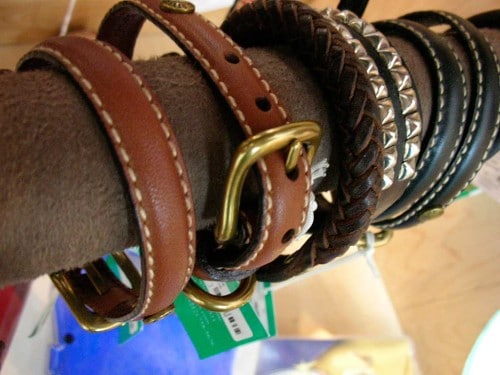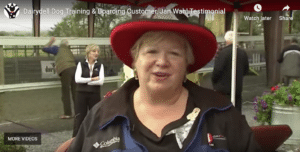Head collars, harnesses, slip chains, martingales and “pokey” styles – so many collars, so little information!
How do we choose the RIGHT collar to train our dog? In case you haven’t noticed, trainer recommendations differ widely when it comes to dog training collars. One will advise a head halter, another will prefer a classic slip chain, while still another will recommend either a metal or plastic “pokey” style for your dog. The nerve-wracking part for the dog owner is that each trainer often condemns all other collars when they are recommending their favorite style. If a head collar is preferred, they warn against the evils of slip chains or pokey styles; if pokey styles are preferred, the trainer may “pooh-pooh” head collars as ineffective. What gives, and how can the average dog owner make sense of it all??
A full, informative and fair review of training collars is way overdue, I think. Let me give it a whirl from what I hope will be a more broadminded, natural perspective. What I’ll do is review the major training collar styles from the DOG’S PERSPECTIVE, because the purpose of any training collar is to communicate with the dog: where you want him to go, where you don’t want him to go; what you want him to do or not do, etc. Collars are tools for communication. Which collar communicates what to the dog, and how? I’ll try to answer these questions and I hope you find my take on the subject interesting and insightful. I hope it inspires more questions and comments and opportunities for discussion. Drumroll, please…
Head Collars and Harnesses
You’ve seen dogs being walked in head collars. You may have even mistaken a head collar for a muzzle. There are several different brands on the market (IE: Halti, Gentle Leader), but they each have one thing in common: control through the physical restraint of a nose band. When the dog pulls ahead on the leash attached to a head collar, pressure is put on the dog’s muzzle (by the noseband) which slowly brings his head to the side and interrupts the physics of pulling. Harnesses also utilize physical restraint as their modus operandi, whether the leash attaches classically on top of the back, or in front of the chest.
From the dog’s perspective, head collars and harnesses mimic the mother dog, who uses physical restraint to teach her young pups boundaries and to stop behaviors she does not approve of. Before weaning age, she will often put the pup’s muzzle in her mouth to restrain him until he stops whatever he is doing. (This is the rationale behind head collars). Or, she will use her legs and paws or body to physically restrain the wayward youngster. (Like a harness stops a dog’s body). As the pups mature, however, these maternal maneuvers become less and less effective – like trying to hold a child’s hand to cross the street when they are 12 instead of 3. It works for the 3 year old, but the 12 year old will have none of it. Once a puppy has left the mother and entered life in the adult dog world, simple physical restraint is not very effective. He is now learning his boundaries from older dogs who use growls, barks and nips. Mother dogs, by the way, also teach their puppies this adult dog “language” before weaning age to prepare them for this next developmental life stage. They will curl their lip, growl, bark and even nip their puppies. It is their way of teaching their offspring the language of dogs (I call it Dogtalk) that they will need as they leave her and move on through their adult lives.
Because our pet dogs come into our families after weaning age, it is not unusual for head collars and harnesses to be ineffective, or marginally effective. The dog has already grown out of the developmental stage in which a head collar or harness could have been more clearly understood.
There is ONE EXCEPTION, though! Certain dogs retain their puppy-like personalities even after they mature physically. The scientific term for this phenomenon is “neoteny”. It means the retention of juvenile characteristics into adulthood. These neotenized dogs are consistently sweet, submissive, compliant and eager to have their “mommy” tell them what to do, regardless of their age. Neotenized dogs can do GREAT on headcollars and in harnesses, because these speak to their juvenile characteristics. I have trained a number of adult dogs successfully on headcollars.
Slip Collars and Martingales
Now here we enter the swirling waters of disagreement between dog trainers.
Slip chains (also called choke chains) are a classic dog training tool that has been around for years and years. Because, however, slip chains can be used in a variety of ways – from benign to dangerous – most trainers are respectful of them, and some eschew them altogether. I’ve never liked extremes or sweeping generalizations because I don’t find them fair. That’s the case for me and slip collars. Can they be dangerous if used too roughly on tiny dogs? Yes! That’s why very few trainers recommend them for toy breeds. Can they be dangerous to larger dogs when used too strongly or in anger by the owner or trainer? Of course. Are they inherently dangerous? I don’t think so.
Properly used, a slip chain collar simply uses a combination of sound and physical sensation to communicate boundaries to your dog. A quick, but light snap of the leash makes a “zip” sound as the chain runs through the ring (like a “bark” in Dogtalk), and the quick tightening of the collar also sends a light “nip” message. The adult dog is naturally controlled by the barks and nips of his pack mates in Dogtalk everyday, so a slip chain is potentially an effective communication tool. If your dog responds to this light “bark and nip” message from the slip chain collar, it might be a great choice for you. I’m using a slip chain to train a Doberman right now, and a light touch from it is perfect for his sensitive personality.
A Martingale collar is sort of a cross between and normal flat collar and a slip chain. The part of the martingale that goes around the front of the dog’s neck is usually flat nylon webbing, with a tightening chain portion across the back of the neck. When the leash is snapped, it makes only the “zip” sound. The “nip” is not there. Because there is no chain in contact with the dog’s throat or trachea, a martingale collar does not have the same potential for dangerous misuse as its classic slip chain cousin.
Pokey Collars
Dare I speak of these? There are no collars on the market more controversial than “pokey” styles, so I’ll cover them at length. I’m talking about the collars also referred to as “prong collars” or “pinch collars”. Traditionally, these were always metal, with “prongs” that apply quick, pinpoint pressure on the dog’s neck when the leash is snapped. The metal versions continue to be the most widely used, but recently a more dialed-down, plastic version has made its way onto the market for more sensitive dogs. Whether plastic or metal, both collars work on the same principle – translating a leash snap into a “nip” at the dog’s neck. This “nip” communicates a behavioral boundary to the dog, just like a canine pack mate would do in Dogtalk.
Can pokey collars be misused? Indeed! Are they evil? Do they cause aggression in dogs? Are they inhumane? Not if they are used correctly. What’s correct and what’s incorrect? Now THAT is where the discussion should be centered. Properly used, these collars can be a godsend for a dog owner; improperly used, they can be disastrous. The devil’s in the details. Like water – too little, we perish; too much, we drown.
The sole purpose of a pokey-style collar is to communicate a “nip” in Dogtalk. To use this collar correctly, it is imperative to understand, however, that when dogs nip each other they do not necessarily do it in anger or want to fight. A nip between dogs is just communication, as one dog defines a behavioral boundary for another. Once one dog’s boundary is understood by the other, both dogs resume their play. No harm, no foul. Life is good.
When humans use a pokey (nipping) collar in the correct matter-of-fact, non-emotional way, my experience is that this collar is not only safe but capable of producing profound results AND a happy dog. The dog understands exactly the boundary that is being communicated, whether it is to say “Don’t pull”, or “Please don’t get up when I’ve asked you to Stay”. On the other hand, I’ve seen these collars used to punish, to intimidate, to hurt or to confront – and when misused in this way, they can indeed create a defensive reaction in the dog. If someone were beating up on me instead of just talking, I’d fight back, too. In cases where the pokey-style collar is misused, I don’t blame the collar. I blame the “jerk” at the other end, pun intended.
Because pokey-style training collars can communicate so clearly, they are frequently useful at the beginning of a training program to quietly convey the leadership dynamic and basic boundaries. Once those are established, the trainer or dog owner is often able to transition down to a more subtle style of training collar for maintenance purposes. This might take the form of a slip chain, a martingale or head collar, depending on the dog.
Remote Collars
It is a shame that this last category of training collars has been so vilified. It is almost routine to hear them referred to as “shock collars”, as if their very intent was to cause unspeakable pain and torture. Of course this is absurd, although the potential for misuse of an electronic collar is exponentially greater than for the misuse of other collar styles. The irony is that although the potential for misuse is high, the educated and correct use of this tool holds greater off leash and distance training potential than all other collars combined. It’s a conundrum.
A remote collar allows an owner (man or woman) to give a subtle, yet clear, I-still-control-you control signal to a dog that is off-leash, at a distance and otherwise unreachable and unmanageable. The signal is similar to that of a nip-like leash tug, only it is sent electronically. On one hand I have seen these collars abused by those who let anger infect their training, and on the other hand, I have seen the world of off-leash freedom opened up to dogs properly trained on remote collars. Certainly, ANY use of a remote collar MUST include professional guidance! If you are considering a remote collar, make an appointment with a trained professional that is familiar with their use.
All training collars are communication devices. The RIGHT training collar is the one that communicates most effectively with YOUR dog! It’s really that simple.
~~~
All training collars are communication devices. The RIGHT training collar is the one that communicates most effectively with YOUR dog. It’s really that simple!
Comments?
– Diva











16 thoughts on “The Great Collar Controversy: A Canine Perspective on Dog Training Collars”
Dear Camilla,
Do you think a harness is appropriate to train a little 10 pound dog. Bootsy’s a great little walker and doesn’t pull on her collar and/or her harness. But there are other types of training that she really needs such as not jumping up on guests, not licking toes (summer sandals just invite her licks), and lastly much barking at the squirrels as she sits at the windows and glass doors inside our house, and lots of barking at other dogs when traveling in the car.
Hi, Polly:
Thanks for your question re: your Bootsy and her behaviors. You say she walks for you perfectly on her harness, but some of her other behaviors still need work.
Think of dog training like a carpenter thinks about building a house. He or she would never use the same tool to build the entire project. To rough cut wood, a carpenter may need a rip saw, while for turning a table leg, he may use a lathe. To finish the project, he will use everything from a screwdriver and nail gun to a grease pencil to a tube of epoxy.
Dog training is like that. Each thing we are trying to teach or change in our dog may require a different tool. You have obviously succeeded in teaching your Bootsy to walk politely on leash using your harness. Bravo! To teach her not to jump on guests, however, perhaps try a squirt bottle, a “bark” can with pennies or a different style training collar and leash. Don’t be afraid to experiment with various tools to clarify behavioral boundaries. And most importantly, don’t forget to reinforce ANY positive change with positive feedback for Bootsy. Praise, fun, food or touch – she’ll love it all!
-Diva
Hi Diva —
Just a question unrelated to muzzles and leashes but you touched upon something interesting when you say: “Before weaning age [mother dog], will often put the pup’s muzzle in her mouth to restrain him until he stops whatever he is doing.”
If your dog is doing something he shouldn’t (barking or nipping, et al), is this a good way to “get his attention”: Gently grab his muzzle and say “No.” Will doing this get him to “get it”?
Bob:
You asked if holding your dog’s muzzle (like a mother dog would do to her pup) would be a good way to stop annoying behaviors like barking or nipping.
It DEPENDS. It can be effective on those “neotanized” dogs that I spoke of in my Training Collar post, but on most other adult dogs, it is more of a bother than a correction. In those cases, muzzle-holds frustrate the dog and do not change behavior. Again… it’s like holding a 12 year old’s hand across the street. It bugs ’em!
A maternal-type correction ONLY works on dogs that have not graduated out of their pre-weaning puppy developmental stage. If your dog is by nature “puppy-like” and naturally sensitive or submissive, he or she may, in fact, be a good candidate for a maternal restraint correction – like holding the muzzle. Try it! If it works, CONGRATULATIONS! You have sweet and sensitive “Peter Pan Dog” – a puppy who never grew up. 🙂 Knowing that will guide you to other training choices as well, like the best style of training collar. If he or she is truly a “Peter Pan”, I’ll bet a head collar could work for you, too!
Let me know.
-Diva
Camilla,
We have a delightful 5 year old Aussie who for the first four years of his life lived with us in Sonoma County with lots of open space and little time on leash. We now live in San Francisco where the times have changed. We have slowly progressed from using a Martingale collar to a pokey as his rate of forward motion would often exceed ours. While he does well on a pokey to us it seems too harsh.
We have seen other dogs wearing a harness type device which has the connecting ring at chest level instead of at the back of the neck. What do you think of these as a way to train a dog not to pull?
Karl:
Thanks for your question. It sounds like you have a dog that has never really been leash trained. On your former property, he roamed free. Now he is a City boy that needs to be on leash, but his mind is still in the country. (You can take the dog out of the country, but you can’t take the country out of the dog…or something like that. LOL)
You have two options: find something that effectively restrains him from pulling, or teach him not to pull in the first place. The option you choose will determine the collar or harness you use.
The harness with the chest ring can effectively pull the dog off balance, hence prevent him from pulling like a longshoreman. He can’t get the torque going with his hind legs and front legs…because the front legs are brought out of line when the leash is pulled. It’s a clever mechanical device that can work, if all you want is to restrain effectively. The harness will not, however, teach your dog not to pull. For that, you need leadership, rank and rules.
The pokey collar you have, if fitted and used properly, can actually teach him that pulling is not allowed. As your dog’s leader and teacher, you would “nip” quickly with the collar when your dog pulled ahead by flicking the leash to tell your dog, “Hey, fella – I don’t allow that”. Remember, the pokey collar is only “harsh” if you use it harshly; otherwise, it is just Dogtalk. Most dogs are fine with it. If your dog is super-sensitive, try a plastic version instead of metal. They are sold under the name “Good Dog Collar”.
Let me know how it goes!
-Diva
Hi, Karl:
I seem to be finding unanswered blog comments today – good grief, yours is from MAY!!! I’m so sorry…
I hope you reread my blog post on Collars. The ‘correct’ training collar or device is the one that communicates appropriately with your dog and conveys your message that pulling in not allowed (if that IS your message!) Harnesses and halter collars can communicate this, but only to dogs that are very baby-like, very submissive or sensitive, since these tools are designed to communicate the same way a mother dog would with her young puppies (Maternal Restraint.) If your dog is older, willful, headstrong or just plain strong, usually the harness is not an effective training tool at that point – it’s just a restraint to make pulling difficult; it does not teach the dog to avoid pulling.
Many times using a halter collar or harness (that uses teaching methods meant for a puppy’s developmental stage) on a older dog is like holding your 13 yr old’s hand to cross the street – it worked when they were 3, but at 13 they want nothing to do with it!
Let me know if you still need help with this issue. If you are in the Petaluma area, you might want to schedule an hour with me to work on pulling and further analyze your training collar needs. Again, so sorry for missing your question the first time around, Karl!
Hi, Karl:
The “correct” collar is the one that effectively communicates with your dog. Each dog is different — like children are different. If your pokey-style collar is successfully communicating to your dog that you do not want or allow him pulling or walking ahead of you on leash, and he remains happy and bright — it’s the perfect choice. It may not be perfect for other dogs, but it’s perfect for HIM.
Though a pokey style collar LOOKS harsh, it’s design is based on mimicking the mother dog’s nip, which communicates behavioral boundaries to her puppies and prepares them for understanding the language of dogs as the grow up and eventually leave her care.
Read my earlier post, “The Great Collar Controversy”, in which I explain the many collar styles from the canine perspective. And…happy walking!
-Diva
Thanks Camilla:
We will stick with the pokey collar and just spend a lot more time street walking (a popular past time in a number of neighborhoods in this City).
I will let you know how we do in this new venture.
-Karl
Karl:
I’ll be eager to hear how it goes. Dogs (and our skills) are always a work in progress. 🙂
-Diva
Hi Camilla,
Thanks so much for all the useful information! My sister is having a lot of confusion regarding training philosphies and, especially, training tools. I personally use a Gentle Leader on my B.C. mix who responds well to it. Naturally, I recommended the same for her. The info you give on that is very enlightening and I learned even more on it that I didn’t know.
I’ve started venturing into the dog training world myself (and even blog about it) and trying to figure it all out can be quite confusing. I’m glad to know there are people like you out there offering advice that is clearly attempting to be more objective and considering all perspectives on the issues at hand. I definitely feel I can learn a lot from your blog/experiences. Thanks!!
Thanks, Jasmine!
I’m glad you see how Nature’s larger perspective actually makes sense of ALL training philosophies. The biggest “ah-ha” is that competing training styles are not in conflict with each other at all; these various approaches are really just parts of a greater, more comprehensive whole. One cannot see the big picture, however, unless one steps WAY BACK and looks from Nature’s much broader vantage point. Nature is the ultimate teacher!
I’m walking a neighbour’s dog, Leah. A tiny terrier-type mixed breed. The owner never walks her and she’s always in a hyperactive state, jumping, jerking and twisting like she’s being electrocuted. But I love walking and love to watch this animal enjoy the mountain with me, where I can give her lots of off-leash time.
Leah, however, needs to be restrained under stressful situations (when another dog approaches). She easily pulls out of an ordinary leather collar. She has also managed to Houdini out of her harness. (The harness is also a nuisance because she keeps getting tangled in it, even when she she is off leash and running free, I have to keep readjusting it and put her feet through the right loops again.) If I can be pretty certain that I can restrain her, I will feel more relaxed and this will convey more confidence to her when we approach other dogs. So I tried a slip chain, but I feel no more confident, just how hard can she pull before she strangles herself?
She’s over a year old now and I quickly taught her to sit and lie down. (Although this only works at the end of the walk, not at the start when she is still in a hyper state.)
I would appreciate any thoughts on how I can easily and confidently restrain her when another dog approaches (she starts to growl and bark aggressively and charges). She plays happily with dogs her own size, chasing and being chased, but I’m terrified of what a big dog, failing a sense of humour, might do to her.
Kind regards
Anna
Hi, Anna:
It sounds like little Leah could benefit from knowing exactly who is in charge when she is being walked. The behavior you are describing is that of a dog that wants to be in front, wants to do what she wants and is fighting for control.
If I were to meet with this dog in person, I would assess what developmental stage she is in. She sounds like a dog that is well past the puppy-mind stage and is ready for more mature Dogtalk communication. I would try a nippy-style collar to establish that I was the leader and that her role was that of follower. If she is like most dogs at her stage of development, they are ready and willing to follow; someone just needs to show her that they are qualified to lead. A nippy-style collare communicates that, as the leader, you do not allow her to walk in front of you. (Hence, no pulling or choking.)
Because the proper use of a nippy-style collar, however, must be demonstrated by an experienced professional, I would suggest that you find a trainer in your area familiar with their use. One place to start is IACP (International Association of Canine Professionals). This is the organization to which both Cesar Millan and I belong. Their website is http://www.canineprofessionals.com. They train from the leadership perspective and understand that traininig is about simple control — not intimidation or confrontation.
Good luck! You and Lucy will soon be enjoying your walks together, I’m sure.
-Diva
Dear Diva,
I like your dog-centered perspective. Would you please consider this question? My 90 year old mother recently saved and acquired a lovely adult dog (Tenterfield terrier we think) from our RSPCA. He is fairly well behaved except when mum takes him for a walk and he happens to spot another dog or a cat. He pulls so hard on the leash that mum either has to let go or he slips his collar. We’re scared he will pull mum over and she’ll break a bone. Someone suggested a pinch collar, but we don’t want to be cruel to him as we suspect he is just wanting the company of other animals (doesn’t attack dogs or cats). What would you do?
Hi, Rosey:
Your mom needs greater control over her new terrier, to be sure. Not to have control will, indeed, pose dangerous consequences.
I think the suggestion of a “pokey collar”, as I like to call them, is a dandy one. Read again my post on The Great Collar Controversy. When one understands that pokey (pinch) collars were designed to actually speak to the dog in his own language — leader to follower — by “nipping” a boundary when the dog tries to pull ahead, it all makes perfect sense. Nature is not cruel in her ways, and neither are pokey collars when used as intended.
You mother needs to find a trainer locally that understands natural training and is familiar and comfortable with the use of pokey collars and can instruct her in their usage. A miracle of control and understanding can happen once she learns how to communicate her boundaries through this or other tools. No yelling, no punishment; just simple “I don’t allow that” techniques when it comes to pulling and charging toward other dogs. The collar can help her to effectively disallow the dangerous pulling.
To find a trainer in your area that understands the proper, humane use of a pinch (pokey) collar, try http://www.canineprofessionals.com and their “Find a Trainer” button!
Best of luck.
Diva